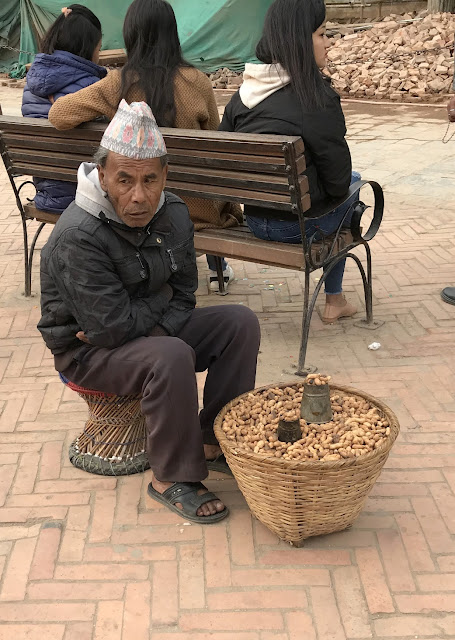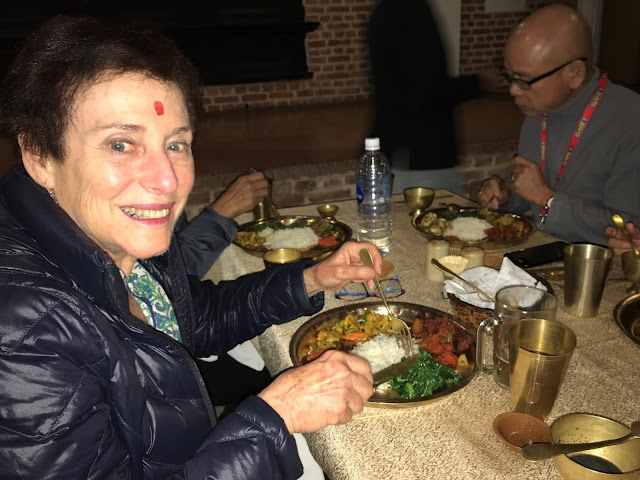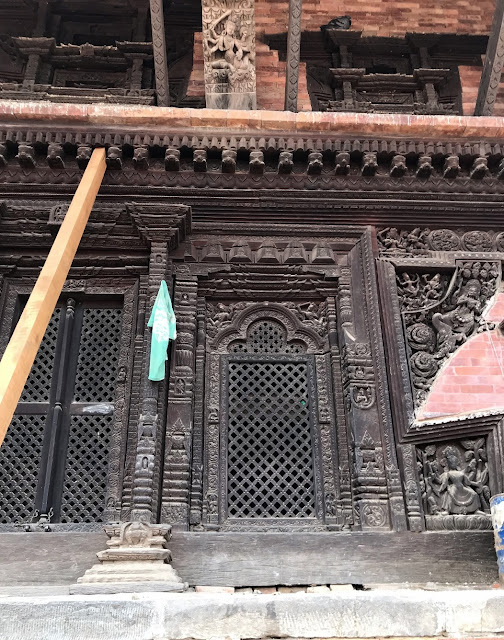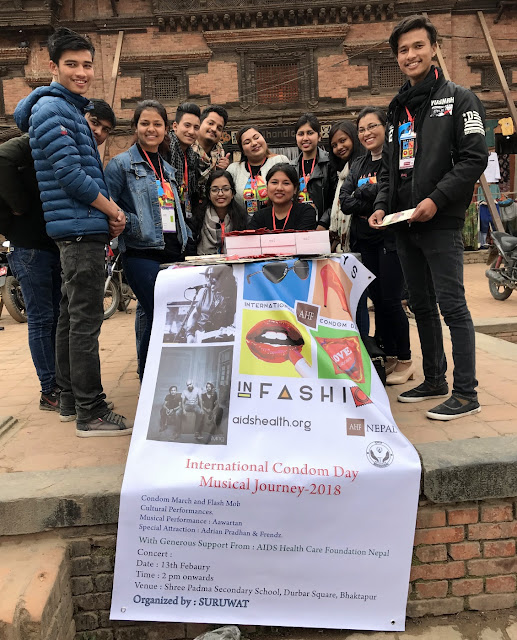The city of Kathmandu is only about 4,400 feet above sea level. The main industry is tourism--trekking and many visitors--and also agriculture is important. A lot of money comes into the country from citizens who have overseas jobs and send money home. Many men went abroad during the civil war.
The local currency is the Nepalese rupee, but stores also take Indian rupees as well as dollars so one has to verify which currency is being quoted. There are approximately 100 Nepalese rupees to the U.S. dollar.
We saw Nepalese bills from 5 rupees (worth about a nickel) up to 1,000 rupees worth about $10 . The front had pictures of the Himalayan mountains. Mount Everest, known in Nepali as Sagarmatha and in Tibetan as Chomolugma, is Earth's highest mountain above sea level at 29,029 feet (8,850 meters) above sea level.
The back had a picture of a local animal. The value in Arabic numerals is located in the top right (10 below) and in Nepali in the left (which looks like a 90 to us).
 |
A mountain goat on the 50 rupee note.
May favorite was the yak on the five rupee note. It was smaller in size than the other rupee notes which are all the same size.
 |
| This was the only note I remember seeing with a stupa on the front in addition to the mountains |
 |
| And a yak on the back |
Kathmandu can refer to the city itself or the whole valley which also includes two other cities (Patan and Bhactapur). A total of about four million people live in this valley. It also has seven world Heritage sites. A total of about 29,000,000 people live in Nepal, many in rural areas. 81% of the population is Hindu, 9% Buddhist, and 5% Muslim.
Nepal was never colonized but its fighters were respected by the British in the war of 1814--16 so they recruited a group of Nepalese to their army called Gurkas.
The country from West to East has two sets of mountain ranges. The center between has green hills and valleys. 27% of the land is fertile for agriculture and many people are farmers..
During rough times, especially after the murder of the king and his family in 2001, young Nepalis have gone to the Middle East to work, to such places as Oman, Qatar, the UAE, and also South Africa. The women were left to tend fields, a heavy burden on them in addition to all of their other responsibilities. But the men send back money to their families, which helps the economy.
The Newar people were the historical inhabitants of the Kathmandu Valley and surrounding areas of Nepal. Now, they are half Hindu and half Buddhist but share deities and festivals. About 65% are from a subsistence agricultural background. 60% of marriages are arranged in the same caste. We were told that there are 103 ethnic groups in Kathmandu and that people had lived there since the 1100s. The wood carvings on the windows and doors are traditional.
We met our local guide, Anita, at the airport and were given scarves by her as we boarded our bus.
We then went to our hotel, the Shambala, a cute boutique hotel in an older section of town.
Below was the view from our hallway window.
And of sunset from the same window:
Nava and I both got a much needed massage. I got a half hour spinal massage and a half hour foot massage for $27 (including our Gate 1 discount) and my feet have not felt so good in years! They still feel pretty good almost two months later!
That night we went to the Utsav, an authentic Nepalese restaurant, for an optional special Nepalese dinner and show (for tourists) that our whole group attended. It was definitely worthwhile.
 |
| Blanca receiving the traditional greeting |
 |
| Me too. Wow! I feel tall in the picture! |
The food and the service were excellent, and the show was very professional and captivating. It was much more entertaining that the shows we saw in India, especially the one at the optional dinner.
 |
| The announcer in a beautiful dress |
 |
| The first performance--the costumes were lovely! |
 |
| Momos |
 |
| Chris being served momos |
 |
| This dancer was the highlight for me. His posture, composure and balance was amazing and he always had a slight smile. |
 |
| This costume and the dancer's constant movement was fascinating |
 |
| And Arlene and several others joined the dancers too! |
In the 1960s and 1970s, a lot of hippies came to Nepal, so the government outlawed hashish except for use by religious leaders at festivals to honor Lord Shiva, and fewer hippies have made their way to Nepal.
The next morning we worked out way out of the city slowly because of the traffic.
 |
| A typical building along the way |
 |
| People waiting for a ride and vendors selling fruit and clothing |
We then headed to the hilly rural area to (hopefully) get a good view of the Himalayas.
 |
| A brick business |
We saw terraced fields and homes along the way.
 |
| Terraced farming |
 |
 |
| Lots of potatoes growing, and mounded up |
We also saw a famous statue of Shiva on a tall hill by the road. It is called the Kailashnath Mahadev Statue and is the world's tallest Shiva statue at 144 feet (44 meters) tall. It was finished in 2010. The statue's foundation is 100 feet deep to anchor it on the ridge. Wow! It is part of a complex that houses a six-room resort, spa, yoga, health club and meditation center. About 5,000 people visit it on weekdays and more on the weekends, helping to increase tourism in the region.
 |
| Almost like a painting but not a mountain view |
But a nice place to take picture of friends.
 |
| A Planter |
 |
| A small shrine |
Below is what the view we would have seen on a sunny day. The mountain top peeking out to the right is Everest.
We were in the place where her left hand was. Mt. Everest was by her right hand so it would have been hard to see from that vantage point.
We next drove to Bhaktapur, one of the three cities in the Kathmandu Valley and followed Anita and the Gate 1 sign as we walked around and using our whisperers again. The tents in the background are temporary housing for some of the people displaced by the earthquake.
When we walked up the street below, we were advised to walk on the steps as the middle part was often used by motorcycles!
Below you can see bricks to be reused for restoration of buildings. 70% of the restoration must be from reused materials whenever possible.  |
| Buildings under remodeling/restoration |
I was impressed to see the recycling containers, but when I looked into them, they didn't seem to be used, at least that day.
 |
| Men in typical Nepali hats (called Dhaka topi) sitting and waiting |
This square also has the tallest pagoda in Nepal, the Nyatapola Temple, which is five stories high and has been restored.
.
The Nyatapola temple is dedicated to Siddhi Laxmi. It was built in 1702 in less than seven months. It has five roofs with elephants in front. The king at that time originally laid some of the brick in the foundation.
The Square is the plaza in front of the royal palace with at least eight temples in the square.
There are many wood artisans that can help with the restoration. There is intricate wood work on the doors, window frames and other parts of the building. Here is an example of one:
With amazing stone sculptures above
Buildings, such as the National Art Museum below, are braced to prevent further damage.
But few Nepalese today work in the difficult art of stone carving, so seniors have been called out of retirement to do the job. They are also teaching younger men to become stone carvers for there will always be a need for restoration work.
 |
| What a temple will look like after reconstruction |
 |
| Bhanu is an animal lover, especially dogs |
We were told that Nepali girls "marry" three times: At ag 6 or 7, they marry a "wood apple," which is the incarnation of Lord Vishna. Just before puberty, they marry the Sun god. Then at legal age of 18 or later, they marry a human. In rural areas, girls still often gett married between 14 and 16. There are lots of restrictions to widows for rituals, but for Newari, if their human husband dies, they are still married to the wood apple or Sun god, so they can still participate in rituals.
Several of us ate lunch at the narrow, three-story Cafe Nyatapola in the Square at Bhanu's suggestion. Bhanu and Anita also ate there:
Nava and I had delicious, creamy buffalo yogurt. Buffalo is a staple meat in Nepali diets. Nava had had buffalo yogurt in Israel too.
I also had a delicious Nepali chicken noodle soup (thukpa) at Bhanu's recommendation. YUM! I hope to try to make it. Recipes are available online.
Bhanu warned us that this square is a place with aggressive hawkers, so he advised us to ignore them, not to look at them and not to say anything and they take our speaking to them as a sign of interest, even if we way we are not interested.
During a bit of free time in the square, Nava and I went to a store selling wood crafts made by families in the area.
I loved the owls, some of which had little carved owls inside, and bought two.
We also stopped at several clothing stores. Nava got a pair of yoga pants and I got a pair for my granddaughter who likes shocking pink right now. The clerk told us she was happy as this was her first sale of the day.
We also saw youth promoting condom use, International Condom Day, and an educational musical!
To get there, we walked down an area referred to as "gold street," with an amazing amount of stores selling items, mostly from 24 carat gold. Someone on the web said to avoid the Thamel area and go to the side streets!

Durbar Square in Khatmandu is smaller than the one in Bhaktapur, but had more buildings of which 80% were damaged in 2015. In Nepal, Sunday is a work day. The earthquake took place on a Saturday which is a day off from work. Many people were in the square and as a result 1100 were killed by the museum area.
Our first stop was the Temple of the Living Goddess. The idea of the living goddess dates from the 1750s. There is a fascinating story about it on NPR, where a former living goddess is interviewed. Click on the previous NPR letters to read it.
There are a number of Living Goddess temples in Nepal, but the one in Kathmandu's Durbar square is the most famous, and had little damage during the 2015 earthquake.
Kumari is the tradition of worshiping young pre-pubescent girls as manifestations of the divine female energy ("devi"). Kumari come from Sanskrit and means "princess."
A young girl in Nepal between 3 and 5 is chosen from a high cast, usually Hindu but can be Buddhist, and is worshiped by both groups. She lived in a special temple and remains there until she reaches puberty when she goes back to her family and a more normal life. She only leaves the temple to go to public events. Her parents at this particular temple stay for several months to acclimate her and then return home. They can visit but she doesn't visit them at home.
The selection process is rigorous. I found a lot of this online.
Eligible girls are from the Newar Shakya caste of silver and goldsmiths. She must be in excellent health, never have shed blood or been afflicted by any diseases, be without blemish and must not have yet lost any teeth. Girls who pass these basic eligibility requirements are examined for the battis lakshanas, or thirty-two perfections of a goddess. Some of these are listed below::
- A neck like a conch shell
- A body like a banyan tree
- Eyelashes like a cow
- Thighs like a deer
- Chest like a lion
- Voice soft and clear as a duck's
In addition to this, her hair and eyes should be very black, she should have dainty hands and feet, small and well-recessed sexual organs and a set of twenty teeth.
The girl is also observed for signs of serenity and fearlessness and her horoscope is examined to ensure that it is complementary to the King's. It is important that there not be any conflicts as she must confirm the King's legitimacy each year of her divinity.
The temple of the Living Gossess is a World Heritage site but is taken care of by the Neari people.
Below is the entrance to the Kathmandu Temple of the Living Goddess:
The detailed art work is amazing!
You can see better photos at:
https://www.google.com/search?q=temple+of+the+living+goddess,+kathmandu&rlz=1C1LENP_enUS507&source=lnms&tbm=isch&sa=X&ved=0ahUKEwjP-NO8xtjaAhXBZd8KHez2BlkQ_AUICigB&biw=1291&bih=635#imgrc=iZzTBHiBwDzjJM:
or just Google Temple of the Living Goddess Kathmandu images.
We went to a side area of a smaller square to learn about the murder of the king and his family in 2001. I remember the shock of hearing of their murders. The king, queen, their three children and others relatives were murdered. Only one brother of the king survived. The crown price was first accused of the murders as he had fought with his mother that day at a family event and was drunk. He supposedly shot himself in the head, but he was left handed while the attack on him was carried out by a right handed person.
The king was much beloved. It is probably that the attack was a conspiracy of the Maoists with the king's surviving brother. After the deaths, the king's brother became king and tried to set up an absolute monarchy. It led to much instability in the country, and many young people and other men went abroad to work, fearing that the Maoists would take aware the sons or threaten to kill their parents. 17,000 died at the time. Eventually all the political leaders including the Maoists made an alliance and after protesting against the king for 19 days, he stepped down. The compromise was that there would be no more king (not even ceremonial) and a more democratic government would prevail.
Vendors by the square:
We saw large signs of both China and the U.S. contributing to the restoration of temples in this square. 

Below is another building in the square. Unfortunately, it has been over two months since we were there and I forgot the name of the building.
In the square, we saw people offering food (including banana pieces) and lighting candles to the monkey god. This god is always covered with the red cloak of celebacy.
More temples under repair:
Some people sitting on a carved stone that is on the ground.
People sitting nearby
Below is the colorful status of Paleva, the angry form of Shiva. If he is happy, he will swallow our trouble.s
Birds sitting on the roofs of nearby temples, waiting to be fed? Pigeon square is always filled with pigeons. They can damage the delicate wood carvings.
We walked through a covered open area with pictures of past kings and the ceremonial throne.
 |
| Ceremonial throne |
Then we walked by photos of the previous kings in a covered corridor, who ruled after the kingdom was united in the 1700s.
Above: King Prithibi Narayan Shah, The Great King. He was born in 1723, became king in 1742 and died in 1775.Below is King Girbanayuddha Bikram Shah, born in 1797, ascended to the throne two years later and died in 1815, at age 16, too young to grow a beard.
Below is King Berendra Bir Bikram Shah, who was murdered in 2001. He was born in 1945 and became king in 1971. He ruled for about 30 years before his death and was much beloved by his people and described as one of the few Nepalese monarchs who wanted the Nepalese people to experience true democracy.
His oldest child Dipendra Bir Bikram Shah was also considered king for a few days until he died from his wounds and is listed on the wall. There is serious doubt that he murdered his immediate family.
The last king of Nepal was King Gyanendra Bir Bikram Shah, the uncle of the previous king. He was born in 1947 and was king from 1950 to 1951 and then 2001 to 2008 when he was forced out of power. He was very unpopular and tried to restore an absolute monarchy. He was the only family member not killed in the massacre and there are theories that he was involved in the planning of the killings.
Remodeling plan for a temple
King Berendra Bir Bikram Shah, traveled abroad as a student and later in life too. He chose to build a new presidential palace that combine elements of Nepal with elements of the 20th century Europe. . The wood trim below is completely Nepalese.
Below are some of the people we saw as we finished our day of touring.
 |
| A street sweepert, a common scene |
 |
| A seller wearing the typical men's hat |
 |
| A woman selling peanuts |
 |
| A street vendor with small amounts of a large variety of vegetables |
 |
| A woman cooking on the street |
We were on our own for dinner, so Nava and I walked to a restaurant suggested by our guide Anita. She had not been there but had heard it was good. It turned out to be a Thai restaurant and was almost empty. It was OK... I had the traditional Nepalese chicken soup again.
That's it for now! The final installment on this trip will be in the next blog. I hope you have enjoyed it!





















































































